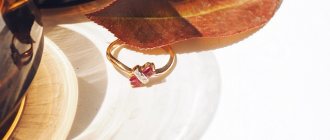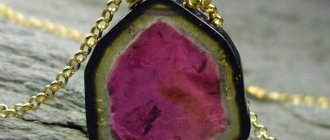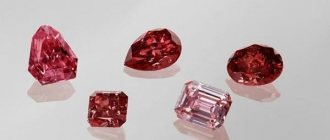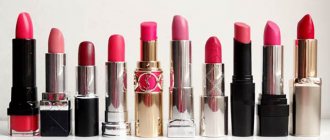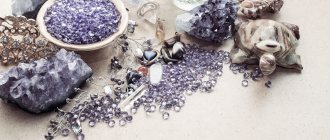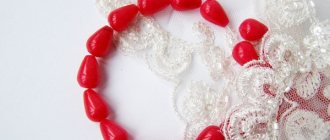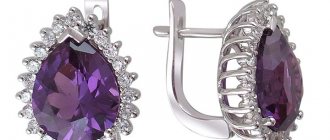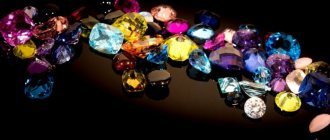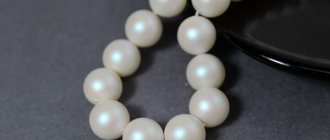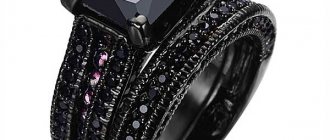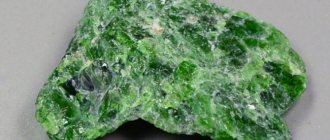What is a ruby
Ruby is the twin brother of sapphire, both of them come from the corundum family. Their base is transparent aluminum oxide, and the red color of the ruby is given by an admixture of chromium. Red corundums are called rubies; the name refers specifically to the color. All other corundums are sapphires, they can be the usual blue color, or have yellow, green, orange and other colors, that is, they can be fancy.
In terms of hardness, corundum is only 1 point worse than diamond (9 on the Mohs scale), so it is perfect for creating jewelry that you will never part with. Since the value of the stones is high, most often you can find gold jewelry with rubies, sometimes platinum. In silver, you will most likely be offered synthetic nanorubies, since the value and strength of natural stones makes it impractical to inlay them into soft silver.
What types of gold jewelry with ruby are there?
The most popular jewelry with rubies in gold are earrings, rings and pendants. Often, red corundums become neighbors of diamonds; such a union allows you to maximize the beauty of a ruby: even a small stone looks very bright, as in this narrow gold ring with ruby and diamonds.
Rubies are cut using the same methods as diamonds and are extremely rarely found in cabochon form. Most common:
- classic round brilliant cut;
- oval, which can be made to order,
- “marquises”, as in gold earrings, where the ruby “marquises” turned into flower petals.
Ruby jewelry for women is most often made in red gold; this color of the precious metal suits the red stone most. Rubies in white metal look simpler, to be admired, they must be truly luxurious.
A 1-carat ruby is rare in nature and such specimens are expensive, so jewelry designers prefer to place several stones side by side to visually enlarge the insert, as in this ring with 3 rubies and diamonds, or in these gold earrings.
Jewelry with rubies
Good afternoon This article will focus on jewelry with rubies . Ruby is one of the most expensive gems. And here the main role is played by the incredible shine of the stone, reminiscent of the bloody reflection of a flame, and the high degree of hardness, in which it is second only to diamond.
As is known, rubies exceeding a mass of 2 carats are rare. The photo shows a gold pendant decorated with pearls and rubies. France 1800-1809 The diameter of the decoration is 5.3cm. Located in London, in the British Museum:
Therefore, such a pure stone costs several times more than a diamond of the same size. The most valuable are considered to be “pigeon’s blood” rubies and stones with the effect of asterism.
The best examples can fetch up to $200,000 per carat, while the average price for such rubies ranges from $50 to $10,000 per carat, depending on the quality and color of the stone.
Ruby cut shapes
The shapes of stone cuts are varied and depend primarily on the product for which they are intended. Transparent rubies are cut into circular, oval, square, pear-shaped, heart-shaped, “marquise” (visually increasing the weight of the stone) or “octagon” (stepped rectangular cut).
The photo shows a falcon figurine made of 750 gold (18 carat) and inlaid with rubies, emeralds, diamonds, sapphires, and onyx. Jewelry enamel was also used. Located in Qatar, Doha, Museum of Islamic Art:
Translucent, cloudy, stones with an asterism effect are polished into cabochon shapes to observe how a star glides across its surface when the gem is turned.
For ideally high-quality star rubies, the star is located exactly in the center, and its rays reach the girdle (the belt around the perimeter of the largest section of the stone). Such gems are very rare and expensive.
Ruby deposits
Today, the main deposits of the mineral have been practically depleted, and new ones are still under development. synthetic rubies are mainly found in jewelry .
For refining, low-quality stones are taken, which are processed using special methods to improve the color and remove small cracks. This is done with oil (over time it can dry out or leak out and the stone will lose color) or the more durable lead.
The photo shows a set consisting of a luxurious necklace and earrings, with rubies and diamonds. This masterpiece was produced by the Cartier company in London in 1954, and to this day is located in London in the British Museum:
Faceted synthetic rubies, or synthetic corundum as they are correctly called, look flawless and are indistinguishable from natural stones without special equipment.
However, there are several rules that will help when buying a stone. If you purchase a large and expensive gem, it is better to consult a hematologist. The photo shows a luxurious brooch with rubies and diamonds. Fulco di Verdura, Italy, 1949:
If you do not have this opportunity, carefully examine the appearance of the stone using a magnifying glass. Natural inclusions in the stone will indicate that this is most likely a real ruby , since synthetic corundums are crystal clear.
The product must have a mandatory tag containing all the data - the name of the manufacturer, metal, insert and their detailed characteristics. Rubies from Burma are more expensive than, for example, those from Thailand; their price can vary by 10 times.
Ruby color and care
A ruby should always be viewed in daylight, as natural light gives misleading information about its color. In ultraviolet light, stones from different deposits glow differently: Burmese ones show a strong red glow, Siamese ones show a slight fluorescence in red tones, and Ceylon ones show orange-red hues.
Jewelry with rubies is cleaned at least once a month to remove the fat layer. To do this, you need to hold them for a while in a warm shampoo solution, and then thoroughly wipe them with a soft cloth that does not leave lint on the surface. Also, ammonia and ordinary vodka are used for cleaning, but in no case bleach, which will discolor the stone.
What is the value of natural ruby
The first stone synthesized was ruby - scientists learned to reproduce it in the laboratory back in 1837. Therefore, it is not surprising that synthetic (hydrothermal) rubies can now be found more often than natural ones. Should I look for stones of natural origin? There are at least 3 reasons to buy a natural ruby.
This is a gem
The quality of ruby synthesized in the laboratory is no worse than natural ruby. The synthetic analogue has the same structure and composition as natural corundum, but, unlike the latter, it grows in the laboratory in a few days. Like everything artificial, it is perfect - there are no flaws in it that can be seen in any stone of natural origin, imperfections that give individuality and make it special. And yet, only a ruby of natural origin can be called a precious stone. This provision is enshrined in Federal Law No. 41 “On Precious Metals and Precious Stones” dated March 26, 1998.
It's a smart investment
Synthetic rubies are several times cheaper than natural rubies, and they are also easier to cut due to their uniform structure. If you wanted to buy a 1-carat natural ruby, you would pay about 350 times the price for a synthetic corundum of the same size. The production costs of jewelry with nanorubies are lower, and the price on a jewelry counter is practically no different from the cost of jewelry with natural rubies. So, when buying jewelry with nanorubies, you always overpay, and they are unlikely to become family jewelry.
This is a talisman
If you believe in the power of talisman stones, you should choose jewelry with natural ruby, because both lithotherapists and fans of the magic of stones unanimously claim that only natural stones have special energy and magical properties. You can believe them or not, but the electron microscope proves that each gemstone has a unique supramolecular structure.
Medicinal properties
The healing properties of ruby have been known since ancient times:
- An amulet with a stone helps increase immunity, improve metabolism, banishes depression, relieves physical and mental fatigue, and relieves insomnia.
- If you keep the stone in water for a day, such water will improve metabolism, help rejuvenate the skin and promote the healing of damaged areas of the skin.
- Lithotherapists who heal people with the help of natural stones use ruby in the treatment of hypertension, diseases of the throat, blood, joints, spine, digestive organs, epilepsy and paralysis.
- The stone helps women get pregnant, get rid of gynecological ailments, and men get rid of impotence.
- Ruby can be used to improve poor vision and hearing.
Where to buy jewelry with natural rubies
You can find a lot of advice on how to distinguish a natural ruby. But let's be realistic: it is unlikely that you will come to a jewelry store with lemon juice or take gold jewelry out of the store before purchasing it to check whether the color of the stone changes in the sun. The smartest decision is to buy ruby jewelry from a store you trust. The jewelry tag will indicate the origin of the insert; legislation requires that stones of artificial origin be marked, for example, “ruby synthetic.”
Diva jewelry stores are perhaps the best place to buy jewelry with natural rubies in St. Petersburg, because the Diva brand specializes in creating gold jewelry with natural stones. We combine modern technologies with the best traditions of the old school of jewelry, so that within our walls you will find jewelry worthy of becoming a family heirloom. A nice bonus is affordable prices from the manufacturer. Choose the real thing!
buy earrings with rubies
